4 Ways to Optimize for Semantic Search in 2023

We have gotten so spoilt lately that we actually feel indignant when search engines do not quite get what we want from them. The main spoiling factor here is, of course, semantic search and its limitless possibilities. Now it can go as far as giving answers right in the search bar:

What do you think about that? Soon even featured snippets will become a relic from the past.
In the light of these exponential developments, I decided to dig into the issue and work out THE strategy for optimizing for semantic search. For the purposes of this investigation, I am taking Google as a guru of semantic search because I'm sure that currently this search engine is really the best among its peers.
Ok, first things first, what is semantic search?
The essence of semantic search lies in efforts of search engines to process natural language and understand query's search intent through contextual meaning in order to provide relevant, personalized results.
Usually, when people think about semantics, they tend to think towards the area of meaning. However, there are a few kinds of semantics. Let's outline those that are important for our investigation:
- Logical semantics deals with relations between concepts/linguistic elements (i.e. reference, presupposition, implication of words). In SEO it can be (and should be!) used to structure content. For example, structured data plays a big role in logical semantics. But not only, logical semantics is also used to build the website itself, i.e. it is found in HTML and site's architecture.
- Lexical semantics deals with the meaning of words and their relations. In SEO it is used to do keyword research.
How does it work?

The pursuit of semantic search by search engines is understandable. First of all, it means less spam, better processing of natural language, and more understanding of search intent, which leads to the best user experience. Second, it is a known fact that data doubles every two years which, in its turn, demands from search engines to better organize, structure, and connect this growing data.
The whole thing with semantic search started with Google's update Hummingbird rolled out in 2013. This algorithm uses context and search intent (not individual keywords in a query like it did before) to ensure that pages that match the meaning perform better than pages that match exact keywords. It was a fundamental change in a way Google delivered its results and ensured satisfactory search experience.
Then, in October 2015, Google launched RankBrain as part of Hummingbird algo. Though its purpose is similar to Hummingbird's, it works differently. RankBrain is a machine learning system that includes two components:
- Analysis of a query — it attempts to interpret queries by associating them with more common ones. The learning process gets activated when the algo encounters rare, ambiguous, or unfamiliar long-tail queries.
- Ranking — to find a good fit for the query, this component analyzes already indexed pages for specific features, e.g., usage patterns of certain related terms. These specific features are determined by analyzing the best-performing search results (according to CTR, bounce rates, time on page, etc.) and looking for similarities between these pages. Thus, those pages that are determined to be good responses even with no exact words from the query, are deemed relevant.
Machine learning vs. Artificial intelligence

People often blur out such terms as "machine learning" and "artificial intelligence (AI)". While combining these two concepts is normal when talking about RankBrain, we should understand that machine learning is not equal to AI. To avoid any misconceptions, let's figure out what these two terms mean in the wild.
Machine learning is the science of making computers come to conclusion based on the data they have but without being specifically programmed to fulfill such tasks. In other words, it is a system that works mathematically to solve problems. Machine learning is a subfield of AI.
Artificial intelligence is powered by machine learning. It is the science of creating systems that have human-like intelligence and process information in a corresponding manner. It means that such systems work in a creative and thus less predictable way, much like humans do when interacting with whatever in their life (they can nail it or get absolutely ridiculous).
There are three classifications of AI:
- Artificial Narrow Intelligence (ANI) — it is AI for solving one particular task in a way that compares to human capabilities or exceeds them (for example, eliminating spam);
- Artificial General Intelligence (AGI) — it is AI that can perform any task. When AI is able to perform like a human, it is considered AGI;
- Artificial Superintelligence (ASI) — AI for any task that performs beyond capabilities of a human.
RankBrain is now classified as ANI. However, this can change really soon, as we now live in the times when technology dramatically revolutionizes the industry on an almost daily basis. It means that in order to stay optimization-competitive, we have to be aware of all the technological advances and try to understand them in the best possible way.
How to optimize for semantic search?

First of all, if you think that you are to optimize for Google RankBrain, you should know that it is kind of useless because RankBrain gets to work when it encounters ambiguous or unknown queries. To optimize for those, you will be fighting a losing battle.
What you should do instead is to optimize for user experience. Yes, I think that UX is becoming king pushing out content out of its warm royal place. Of course, content is still of high blood, but now users are those who tell Google whether any piece of content is good enough. This is a straight (though maybe rather long) way to linkless future.
And please remember that it is a mistake to think that search algo knows more than we do. When Google tries to solve search intent, it uses tons of previously collected end user data to understand what users find relevant. Thus, it needs data to learn and data to guide it once it has landed on your site.
Let's see then what to do to create high quality content that meets user intent and is fully search-engine-crawler-friendly.
1. Create entities.
TL;DR: Semantic entities help search engines to understand natural language and solve search intent. Learn how to create them by applying structured data and becoming a Knowledge Graph entity.
You know, we live in a brave new SEO world. What I'm driving at, it is not enough to do just keyword research now, you have to create semantic entities.
Semantic entities are people, places, or things. Search engines manage to decode natural language by understanding semantic entities, their characteristics, and relationships.
On the whole, entities are at the center of Google's transition from "strings to things" that we have seen with the introduction of Knowledge Graph.

Knowledge Graph (KG) was one of the first steps of Google to understand how people see the world. As a result of rolling out KG, Google now has:
- A huge database of common information (capitals, heights and lengths, birthday dates, etc.);
- Characteristics of each entity (for example, any place is situated somewhere geographically, may consist of smaller entities or be a part of a bigger one, etc.).
1) Apply structured data to your site.
In order to successfully create your own semantic entities, you have to make sure that search engines will properly index them as well as understand the connections between them. The best way to help search engines in this task is to apply structured data.
A universal structured data markup project, Schema.org, was launched by Google, Bing, and Yahoo in order to simplify and standardize the way structured data is applied across the Web.
Go to the Schema site and choose the markup type that is most suitable for your entity (places, persons, local businesses, events, audio-, video-, image-objects, etc.). The good news is that you do not need to be a developer to add schemas to your site, you can do it with Structured Data Markup Helper.
When you are done with adding markup, you can test it with the help of Google's Structured Data Testing Tool.
What's more, schemas are also one of the prerequisites of your content to appear not only in common organic listings but also in rich snippets, featured snippets, and knowledge panels.
2) Become a Knowledge Graph entity.
Knowledge Graph does not refer only to panels on the right of SERPs. Actually, many SERP types are powered by the KG database. Once you occupy any of such spaces, you will definitely gain more visibility.
Before we find out how to get there, let's check whether there is already an entity for your business. Go to Knowledge Graph Search API, enter the name of your brand/product into the Query field, and click Execute:
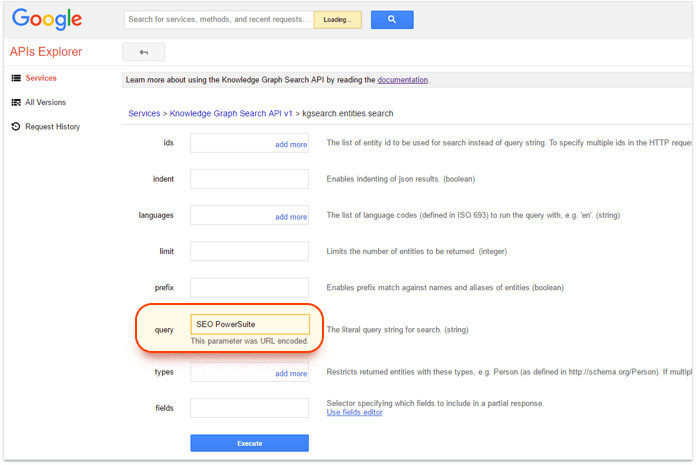
Examine the results. If there is no entity, then the itemListElement array will be empty. If there is a KG entity for your brand, you can see something like this:

If you are not satisfied with the data that is currently displayed for your entity (it is automatically curated which can lead to some ridiculous things), you can go to Wikidata. Use search to find the listing about your company where you will be able to edit the details about your business, like description, contact details, official website, etc.
Or you can suggest changes into your KG entity right from the KG panel in case you have searched for your business name and the panel was brought up to you. Just click on the Suggest an edit option and then verify yourself to proceed to changes:

If your business does not still have a KG entity, try to follow the steps below. We do not talk here about immediate results, but these actions will get you much closer to becoming an entity:
- Use schema markup for organizations for your official website;
- Use a specific type of markup for your product (in the list of product categories);
- Create a Wikidata entry for your business and product. If you are not sure where to start, here is a guide to Wikidata;
- Create a Wikipedia article. The thing is, Wikipedia is one of the main sources that feeds the KG database. You can totally do it yourself, however, it is a good practice to hire an experienced editor. Make sure to include a link to Wikidata in your entry;
- Have your social media accounts verified by the social networks.
2. Pursue search intent.
TL;DR: Search intent and its efficient solving are number one task for Google right now. Learn how to optimize for search intent by doing semantic keyword research.
It is clear as day that while Google pulls all the imaginable resources to solve queries' search intent, it is kind of high time to learn how to optimize for it.
1) Create semantic keyword groups.
In order to perform better in semantic search, you have to step away from old-school targeting of individual keywords and focus on broad topics instead. It means that now you do not have to create dozens of pages to cater to all your target keywords, you can create one or two pages that cover a particular topic in-depth and pursue distinct search intent.
Whatever brand-new strategies you choose to follow, you can't do without keyword research. Rank Tracker keyword research software can help you to find a bunch of keyword ideas to form your semantic groups. Open the tool and go to Keyword Research. Try the Autocomplete Tools and Related Searches keyword research methods where you can use the help of Google itself:


Type in the search box those seed terms that most generally reflect your target topics and click Search. After the tool has collected keyword ideas, you can further analyze them in Keyword Sandbox where they are automatically grouped by themes according to different levels of semantic similarity. You can rearrange your groups at your own will.
Further analyze keyword groups that you have and key performance stats per a keyword group to understand whether a particular group is worth your effort.

Once you are done with the analysis, you can move the best keywords or keyword groups to the Rank Tracking module:
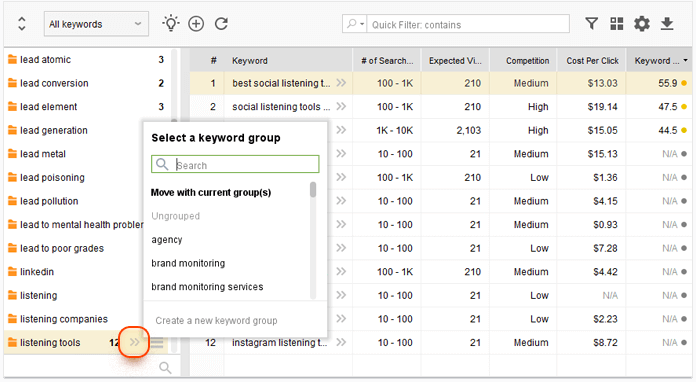
After moving your keywords, you can find them in the Target Keywords module. It is possible to further analyze them or assign your semantic keyword groups to specific pages on your site.
2) Check keywords for relevance.
It is likely that Google uses the TF-IDF algorithm when it receives a query and goes through its index to find the best match.
TF-IDF is the formula of how often a keyword is found on a page (TF - term frequency) and how often it is expected to be found on an average web page, based on a larger set of documents (IDF - inverse document frequency).
Of course, it is not the only factor that determines the final results' delivery. However, by analyzing billions of pages and terms that are used on them, Google learns which of them are related, which ones are synonyms, and which commonly appear in the same context. This data gives the search engine an idea of what terms are likely to be in a given context for a given query.
In the light of this, it is nice to know how topically relevant your target keywords are when comparing to related content.
I would advise you to go through your keyword list and select those keywords or keyword groups that you plan to build your content around for the most important pages.
Then, create a project for your site in WebSite Auditor. When the initial crawl is complete, go to Content Analysis > TF-IDF, add one of those important pages that you would like to optimize, and paste the keywords selected for this page.
The tool will go to Google's search results and pick the top 10 competitors for your keywords to analyze their content and calculate the TF-IDF score for each term's usage on each page. What's more, you will receive recommendations on the usage of keywords for this particular page:
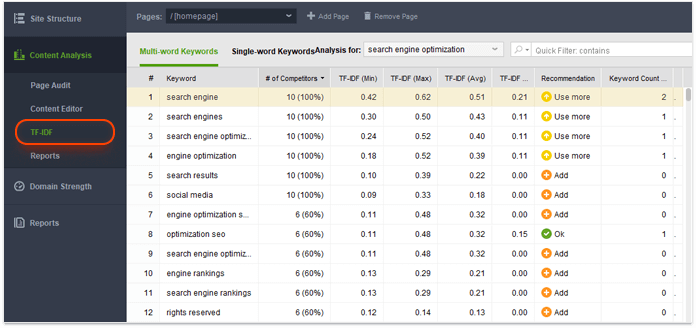
Plus, you can check your keyword optimization in meta tags (like titles, meta description, headings, etc.) in the Page Audit submodule. Watch out for Warning or Error statuses and see how your competitors handled this or that page element by switching to the Competitors tab:
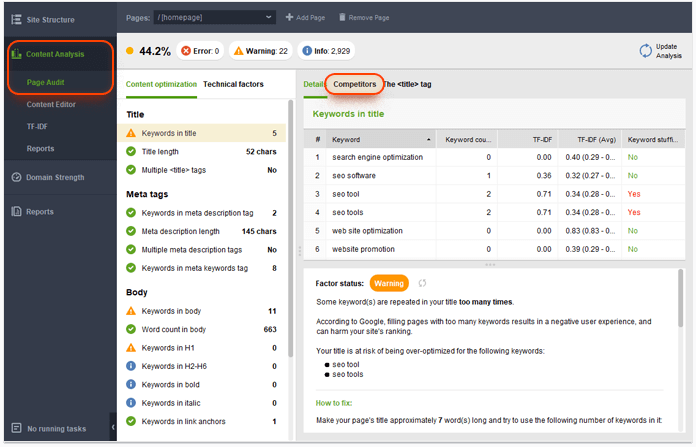
3) Develop content around your users' intent.
You should clearly understand what intent brings users to particular parts of your site. There are three common kinds of search intent:
- Informational — when people are searching for common and then specific information and they are far from buying;
Pro tip: When you pursue informational queries, make sure you do not solely concentrate on the queries that can be easily covered by Knowledge Graph, i.e. those that require purely factual and definitive answers.
- Investigational — when people have processed the info and try to compare to find out what they really need;
- Transactional — when people come to a site with the intention to buy.
When you create your content or reshape your content strategy, define which of the common intents you try to pursue with your important pages. You need to do that to avoid a ridiculous situation when your own pages take traffic from one another. It can happen when you pursue a few intents with specific pages. Your pages should complement and amplify each other, not cannibalize traffic.
After you have dealt with intents you pursue, do a bit of research. Go to Google or any search engine, and feed them a few queries with your target keywords. Study the first page (or a few first pages if you are patient enough) of search listings. Try to figure out what kinds of intent are pulled for your keyword. Do not forget about related searches at the bottom of SERPs.
For example, if I google "red wine classification", I mostly see different kinds of wine that are produced all over the world, like merlot, zinfandel, carmenere, etc. However, the results pulled from Wikipedia are "Classification of wine" and "Wine" and one result is just about Grand Crus. Plus, related searches also suggest to check out white wine grapes:
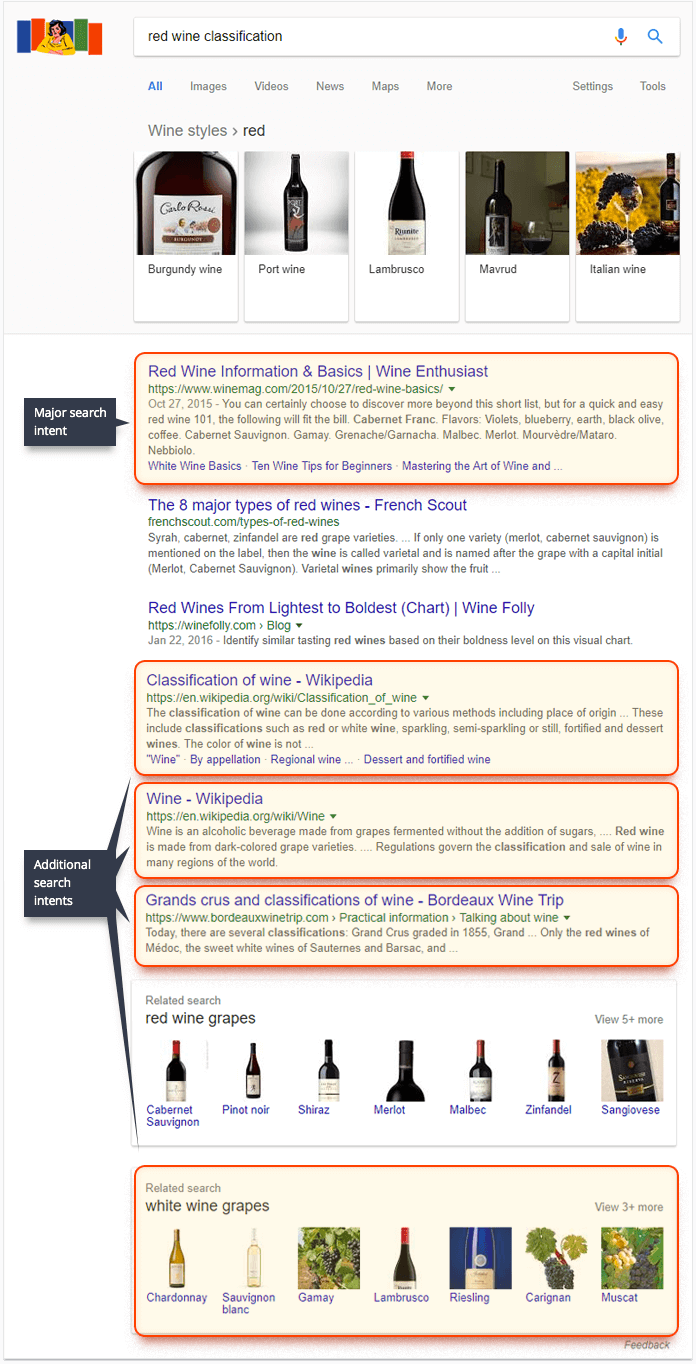
So you see, we've got the following intents here — classification of red wine, common information about wine, the complete classification of wine, and more information exclusively about a particular type of red wine.
Once you have found out the intents that users usually pursue with your keywords, check whether these intents coincide with the intent that you are trying to serve. If yes, good job! Plus, you can spot some gaps that are not filled with current SERPs and jump in with your content to fill them.
If not, then you have to consider rewriting your content (or re-planning your content strategy) to match search intent better or think of another page (or create a new one) to target those keywords and intent.
4) Optimize for voice search.
It happens so that when we talk about semantic search, we also talk about voice search. Why? The thing is, when people search with their voice, they tend to address their devices as if they are human beings, i.e. using naturally sounding queries. They can be colloquial or vague, and here comes RankBrain. Thus, voice search takes an active part in teaching AI to understand a natural language.
Plus, such voice queries are very intent-driven, as people usually use voice search for some information that they need to immediately do something. For example, if I come back to my example with wines, when I ask my voice search about wines, most probably I'm standing in the supermarket and have no idea what to choose.
The best way to optimize for voice search is to think of all possible questions that can come to mind to your potential visitors and then build your content around those questions.
You can think of those questions yourself or use some help:
- "People also ask" box — this is an infinity of related questions and, again, a great way to borrow ideas from Google itself. Just google a question with your target keyword and, most probably, you will be delivered with this magical box. It is really magical because once you click on any question, you will see a bunch of new ones:

- Rank Tracker's Related Questions — Rank Tracker has a great keyword research tool that will give you lots of ideas on your content building. Create a project for your site, go to Keyword Research > Related Questions, paste your keywords into the search box, and wait for the list:
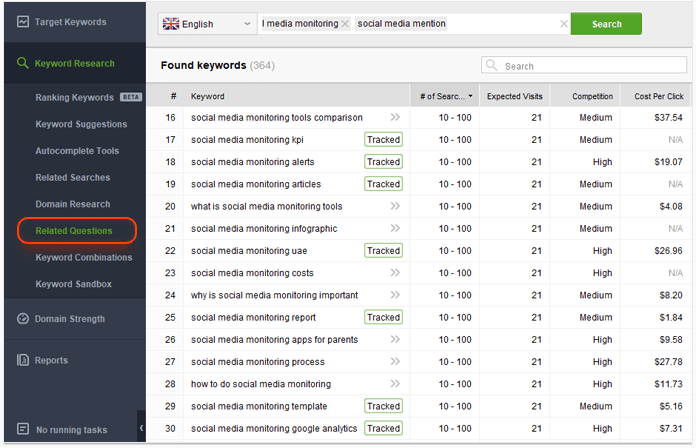
The best thing is that when you optimize for questions, you also optimize for featured snippets, as those are also succinct answers to queries, but! you can see them above all search results:

3. Create topic clusters.
TL;DR: People change their search behavior using more specific queries, thus allowing search engines to learn to understand the topical context behind a query. By building topic clusters, you provide the context for search engines and present yourself as an expert for a particular topic. Learn how to rank higher by building topic clusters through managing your site structure and internal linking.
Whether you have just started to follow a content strategy or continue to pursue it, you need to do it in terms of topic clustering. Why? The thing is, search engines have changed their algorithms (yes, by laucnhing Hummingbird and RankBrain) to correspond to the changes in users' behavior. Instead of fragmented queries, users now prefer rather specific ones with a bunch of keywords. And what's more, they expect results that are delivered fast and fully correspond to their expectations.
As a result, those algos evolved in a way that they can understand the topical context behind search intent. In other words, search engines now do not always need exact keywords to deliver relevant results.
Thus, now many web-masters shift to a topic clusters model. This model presupposes that a single, so-called pillar page serves as the content hub for a particular broad topic, and a number of pages of a related but more specific content link back to the pillar page and to each other.
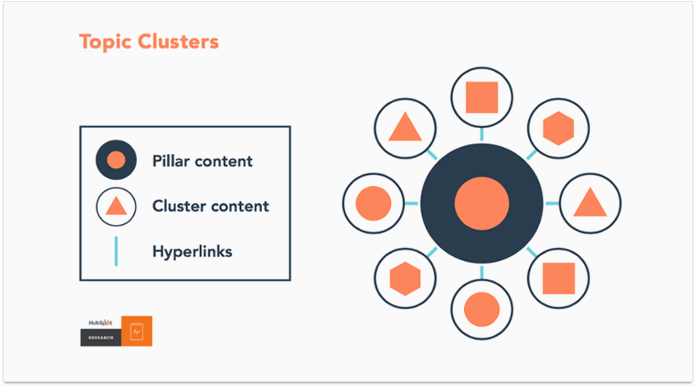
Such a linking structure usually signals to search engines that the pillar page is an authority on this topic, and after scanning the whole interlinked structure, they will see that there is semantic relationship between the pages' content. As a result, the site can be considered an expert on this particular topic.
To prove that, HubSpot launched topic cluster experiments for a specific group of topics in 2016. Their findings showed that the more interlinking they did, the higher rankings were in search results:
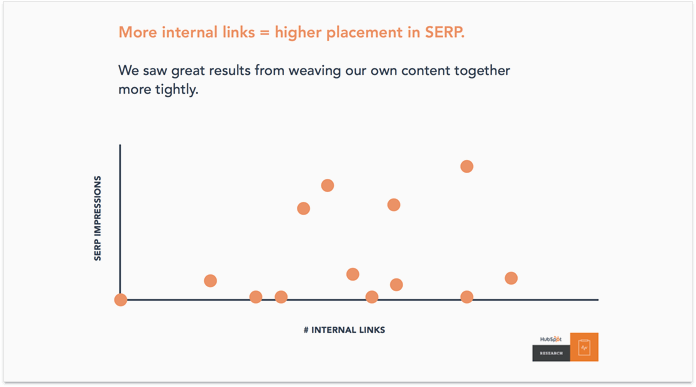
1) Define pillar and cluster content pages.
Think of those topics that you would like your business to compete in (and then base your keyword research strategy within those broad topics). Broad topic pages (aka pillars) should rank for short-tail keywords, while cluster pages — for long-tail.
A pillar page should include all key aspects of a really broad topic. For example, if one of your broad topics is technical SEO, then you should have in-depth cluster pages about usability, search engine crawling, indexing, etc. Try to dedicate your cluster pages just to one in-depth area mentioned on your pillar, so that pages do not cannibalize traffic from each other.
2) Check your site structure.
If you already have tons of related content, and you are not sure how it is interconnected (or connected at all), you can make a good use of the Visualization feature in WebSite Auditor to look at your site structure and all the connections between your pages.
Create a project in the tool and go to Site Structure > Visualization. As a result, you will see the graph of your overall site structure with shortest connections between pages. If you have a big site, then it is a good idea to analyze it by parts (e.g., main categories, the blog, etc.).
Getting back to our task of creating topic clusters, I would recommend to paint those topic-related pages by tags. This will let you immediately see how your cluster-potential pages are connected.
Go to the Pages dashboard in WebSite Auditor, right-click on the pages that you think are cluster-worthy, and choose Add tags to selected record(s) from the menu. Once you are done here, come back to the Visualization dashboard, click the palette button on the left tools column, and set up colors for your tags:
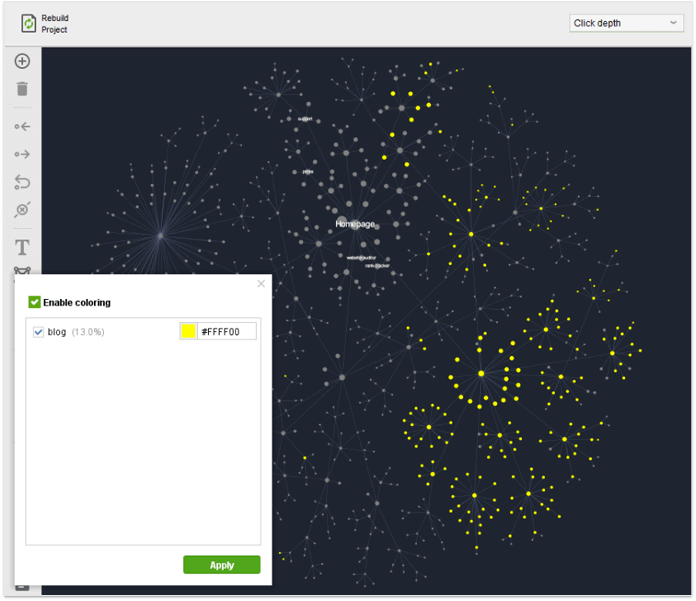
3) Manage your internal linking.
Once you have figured out what your pillar page is and decided on pages that should be a part of a topic cluster, it is high time to form a so-called cluster.
- All the cluster pages should link back to the pillar page, plus, every page in your cluster should be linked to at least once with the same keyword-targeted anchor text. This way, the search engine will know that it is part of a topic cluster.
- Link from less to more specific content that will create topic subclusters and ensure smooth PageRank flow.
- Within those subclusters, link from high ranking to lower ranking pages to increase the relevance of the latter.
4. Amplify your content.
TL;DR: Great content is not always as visible as you wish it to be, so learn how to amplify its visibility with the help of visual means and social media presence.
Even if you are quite sure that your content is of great value and use, you can give it a small push in visibility for users. As you remember, user experience can do magic when it comes to search engine rankings.
1) Do case studies and surveys.
It is not an everyday task, but once in a while, you can put even more efforts and time to research some topic which is ever-burning or currently hot in your industry. You can be running experiments and collecting data to make some ground-breaking or proving conclusions. Or you can be asking your peers and gurus a few questions on some debatable topic.
Believe me, such content will be shared and referenced to hundreds of times and will be appearing in search results for many years.
2) Add useful visual info.
And I'm not talking about memes. Though they surely can amplify what you are trying to say or what you feel about any point. I'm talking about inforgraphics, diagrams, workflows, video trainings, and what not. People like to actively reference such info in their own content, thus providing you with backlinks and love.
What's more, search engines are getting pretty good at understanding what images, audios, and videos are about.
3) Be present on social media.
Experiment with social media platforms and choose those that are the best for amplifying your brand. Share your content there to reach a wider audience. Start discussions to find out what your current/potential users lack or what they are happy/upset about. Plus, social media is a great source of user-generated content, which usually serves as an endorsement from peers.
4) Get customer reviews.
When people write reviews, they use a naturally sounding language and succinct description of advantages and disadvantages of a particular product/place/service. Such content helps Google analyze and return this business in search results for such queries like "best software for checking rankings at affordable price", "best truffle risotto in city X", etc.
Thus, whenever you see happy customers, try to encourage them to leave a review. Positive reviews will show you a highway to local packs and local knowledge graphs. Just make sure you have a complete Google My Business listing.
Dangers of AI.

While we happily enjoy smart inner workings of search engines that deliver to us the information we need and even more than ask for, there are some tendencies of AI that both users and SEO-ers are not quite happy about:
- Pushing out organic listings.
It is obvious that we more or less have said goodbye to just ten blue links when searching for some popular things. Above-the-fold space is now devoted to all kinds of results from Google database: Knowledge Graphs (usually served by Wikipedia), Answer boxes, Image Carousel, YouTube Carousel, etc.

Moz has been running some experiments in the course of which they have found out that SERPs with 10 blue links get about 79% of organic CTR. When a Knowledge Graph comes into play, organic CTR drops to 25%. No comments.
On mobile, you won't even see organic results unless you do some scrolling of course:

- Zero search results.
I've mentioned this curious tendency at the beginning of this post. When you start typing your query in the search bar, you can immediately see the answer if your query is purely factual:
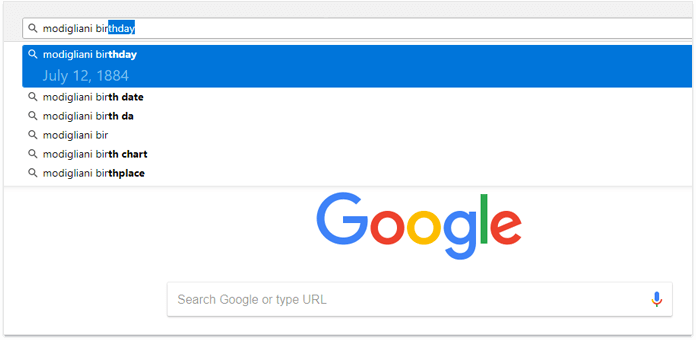
It means that you won't even go to search results if your query is satisfied!
One more disturbing thing is the recent experiment with zero search results: people googled for some factual information, e.g., current time, and they saw this:
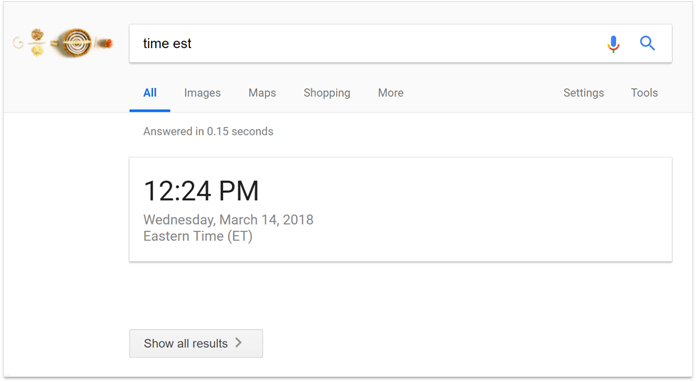
Yes, the answer to their question, empty space, and the Show all results button.
Please do not be nervous, the experiment has been closed, for now. And though such a SERP was delivered only to show local time, convert currencies, and calculate, if it will become a reality, it can as well be expanded over other types of results. For Google it can be faster delivering of results, thus higher efficiency. For SEO-ers — a catastrophe.
- Over-personalized results.
I think you are aware that two different users can see different SERPs for the same query. Usually it happens when users are at different locations and they search for local-based results. Or when they search from mobile or desktop.
Google claims that they have got light on personalization concentrating only on location and language. However, if you experiment a bit, you will see that if you are logged in to your account, lots of factors influence your search results, like your browsing history, browser, social media profiles, etc.
In such a situation, your results are getting really biased. In most cases, you yourself would like them biased because they cover your personal intent better. However, when you would like to get out of this biased reality, you really need to take some precautions, which will not make you feel completely at ease.
A final word.
From the perspective of search engines, it is easy to understand why they pursue the development of semantic search. It means more data, less spam and black-hat techniques, deeper understanding of natural language and search intent. All of these result in providing the best search experience possible.
However, for now it is safe to say that search tendencies are changing, but gradually, not exponentially. You still have to follow the same optimization practices, like keyword research, link building, enhancing UX, and so on and so forth. The only difference is that you need to do it with the thought in mind that you optimize for both users and search engines, and for those search engines that are now able to understand the meaning of a query without exact keywords.
I'm just dying to meet you in the comments to discuss your content strategy, your experience for optimizing for semantic search, and your attitude to AI. If you have any questions or remarks, please join the discussion.

| Linking websites | N/A |
| Backlinks | N/A |
| InLink Rank | N/A |

